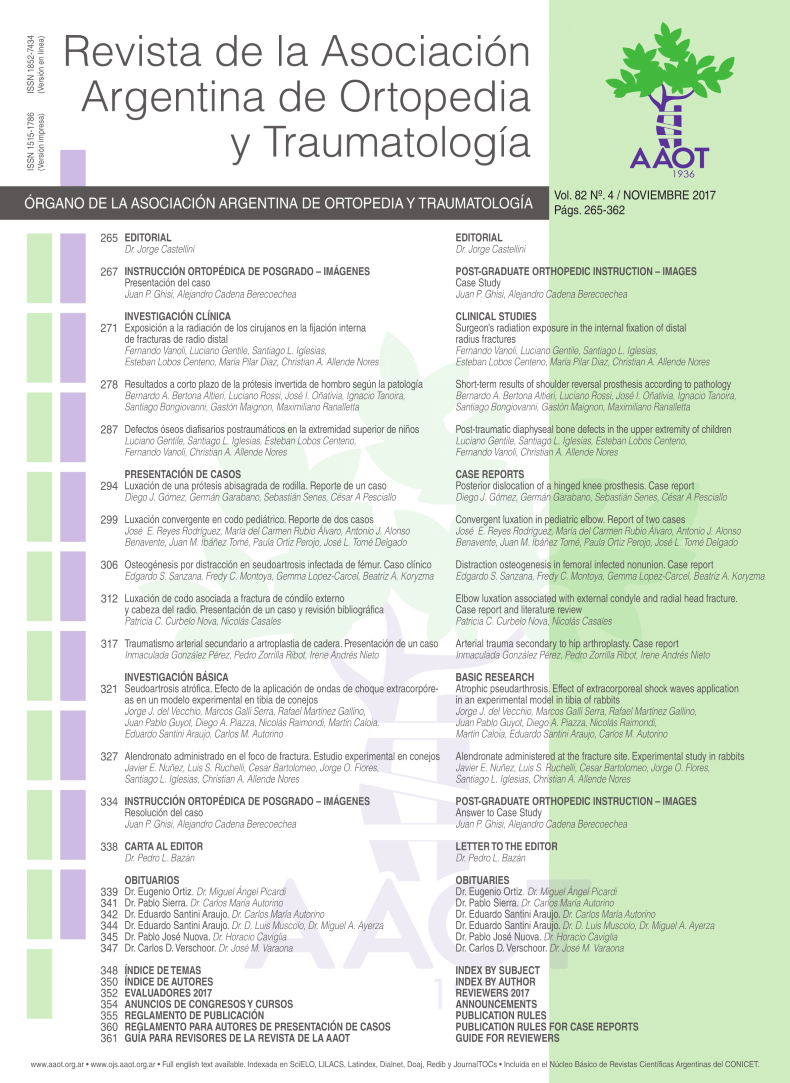Exposición a la radiación de los cirujanos en la fijación interna de fracturas de radio distal. [Surgeon’s radiation exposure in the internal fixation of distal radius fractures].
Contenido principal del artículo
Resumen
Descargas
Métricas
Detalles del artículo

Esta obra está bajo licencia internacional Creative Commons Reconocimiento-NoComercial-CompartirIgual 4.0.
La aceptación del manuscrito por parte de la revista implica la no presentación simultánea a otras revistas u órganos editoriales. La RAAOT se encuentra bajo la licencia Creative Commons 4.0. Atribución-NoComercial-CompartirIgual (http://creativecommons.org/licenses/by-nc-sa/4.0/deed.es). Se puede compartir, copiar, distribuir, alterar, transformar, generar una obra derivada, ejecutar y comunicar públicamente la obra, siempre que: a) se cite la autoría y la fuente original de su publicación (revista, editorial y URL de la obra); b) no se usen para fines comerciales; c) se mantengan los mismos términos de la licencia.
En caso de que el manuscrito sea aprobado para su próxima publicación, los autores conservan los derechos de autor y cederán a la revista los derechos de la publicación, edición, reproducción, distribución, exhibición y comunicación a nivel nacional e internacional en las diferentes bases de datos, repositorios y portales.
Se deja constancia que el referido artículo es inédito y que no está en espera de impresión en alguna otra publicación nacional o extranjera.
Por la presente, acepta/n las modificaciones que sean necesarias, sugeridas en la revisión por los pares (referato), para adaptar el trabajo al estilo y modalidad de publicación de la Revista.
Citas
2-Mastrangelo G1, Fedeli U, Fadda E, Giovanazzi A, Scoizzato L, Saia B. Increased cancer risk among surgeons in an orthopaedic hospital. Occup Med (Lond). 2005 Sep;55(6):498-500.
3-Frazier TH1, Richardson JB, Fabré VC, Callen JP. Fluoroscopy-induced chronic radiation skin injury: a disease perhaps often overlooked. Arch Dermatol. 2007 May;143(5):637-40
4-Tuohy CJ1, Weikert DR, Watson JT, Lee DH. Hand and body radiation exposure with the use of mini C-arm fluoroscopy.J Hand Surg Am. 2011 Apr;36(4):632-8. doi: 10.1016/j.jhsa.2010.12.022. Epub 2011 Feb 23.
5- Chou LB1, Chandran S, Harris AH, Tung J, Butler LM. Increased breast cancer prevalence among female orthopedic surgeons. J Womens Health (Larchmt). 2012 Jun;21(6):683-9. doi: 10.1089/jwh.2011.3342. Epub 2012 Mar 20.
6-Henry AK: Extensile exposure, 2nd ed. Baltimore, Williams And Wilkins, 1970:100
7- Hafez MA1, Smith RM, Matthews SJ, Kalap G, Sherman KP. Radiation exposure to the hands of orthopaedic surgeons: are we underestimating the risk? Arch Orthop Trauma Surg. 2005 Jun;125(5):330-5. Epub 2005 Apr 21.
8-Cogan DG, Martin SF, Kimura SJ. Atom bomb cataracts. Science.1949;110(2868):654.
9-International Commission on Radiological Protection.ICRP Publication 60: 1990 Recommendations of the International Commission on Radiological Protection. Ann ICRP.1991;2:1–3.
10-Bekanntmachung der Neufassung der Röntgenverordnungvom 2003. Bundesgesetzblatt.2003;1:604–635.
11-Vañó E1, González L, Guibelalde E, Fernández JM, Ten JI. Radiation exposure to medical staff in interventional and cardiac radiology.Br J Radiol. 1998 Sep;71(849):954-60.
12-Faulkner K1, Harrison RM.Estimation of effective dose equivalent to staff in diagnostic radiology.Phys Med Biol. 1988 Jan;33(1):83-91.
13-Niklason LT1, Marx MV, Chan HP. Interventional radiologists: occupational radiation doses and risks.
Radiology. 1993 Jun;187(3):729-33.
14-Rampersaud YR1, Foley KT, Shen AC, Williams S, Solomito M. Radiation exposure to the spine surgeon during fluoroscopically assisted pedicle screw insertion. Spine (Phila Pa 1976). 2000 Oct 15;25(20):2637-45.
15-Mechlenburg I, Daugaard H, Soballe K. Radiation exposure to the orthopaedic surgeon during periacetabular osteotomy. IntOrthop. 2009;33:1747–1751.
16-Harstall R, Heini PF, Mini RL, Orler R. Radiation exposure to the surgeon during fluoroscopically assisted percutaneous vertebroplasty: a prospective study. Spine (Phila Pa 1976) 2005;30:1893–1898.
17- Singer G. Radiation exposure to the hands from mini C-arm fluoroscopy. J Hand Surg 2005; 30A: 795-17.
18-Thomson CJ, La Londe DH. Measurement of radiation exposure over a one-year period from Fluoroscan mini C-arm imaging unit.PlastReconstrSurg 2007; 119: 1147-8.

